Practice Corner MCQ
Quiz Summary
0 of 110 Questions completed
Questions:
Information
You have already completed the quiz before. Hence you can not start it again.
Quiz is loading…
You must sign in or sign up to start the quiz.
You must first complete the following:
Results
Results
0 of 110 Questions answered correctly
Your time:
Time has elapsed
You have reached 0 of 0 point(s), (0)
Earned Point(s): 0 of 0, (0)
0 Essay(s) Pending (Possible Point(s): 0)
Categories
- Not categorized 0%
- 1
- 2
- 3
- 4
- 5
- 6
- 7
- 8
- 9
- 10
- 11
- 12
- 13
- 14
- 15
- 16
- 17
- 18
- 19
- 20
- 21
- 22
- 23
- 24
- 25
- 26
- 27
- 28
- 29
- 30
- 31
- 32
- 33
- 34
- 35
- 36
- 37
- 38
- 39
- 40
- 41
- 42
- 43
- 44
- 45
- 46
- 47
- 48
- 49
- 50
- 51
- 52
- 53
- 54
- 55
- 56
- 57
- 58
- 59
- 60
- 61
- 62
- 63
- 64
- 65
- 66
- 67
- 68
- 69
- 70
- 71
- 72
- 73
- 74
- 75
- 76
- 77
- 78
- 79
- 80
- 81
- 82
- 83
- 84
- 85
- 86
- 87
- 88
- 89
- 90
- 91
- 92
- 93
- 94
- 95
- 96
- 97
- 98
- 99
- 100
- 101
- 102
- 103
- 104
- 105
- 106
- 107
- 108
- 109
- 110
- Current
- Review
- Answered
- Correct
- Incorrect
-
Question 1 of 110
1. Question
In most mammals, the testes are located in scrotal sac for
CorrectIncorrectHint
(b) : In mammals, scrotal sacs (containing testes) act as thermoregulator, maintaining the temperature of the testes \(2^{\circ} \mathrm{C}\) lower than that of the body. This temperature is required for the spermatogenesis to occur, otherwise, the sperms could be destroyed by high temperature, resulting in sterility.
-
Question 2 of 110
2. Question
Temperature of the scrotum which is necessary for the functioning of testis is always around _____ below body temperature.
CorrectIncorrectHint
(a)
-
Question 3 of 110
3. Question
The given figure shows a diagrammatic sketch of a portion of human male reproductive system. Identify the parts labelled as A, B, C and D and select the correct option.
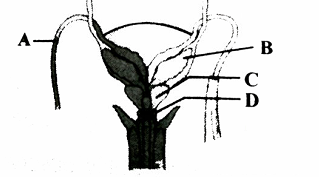 CorrectIncorrect
CorrectIncorrectHint
(a)
-
Question 4 of 110
4. Question
The given diagram refers to T.S. of testis showing sectional view of a few seminiferous tubules. Identify the parts labelled A-D and select the correct option.
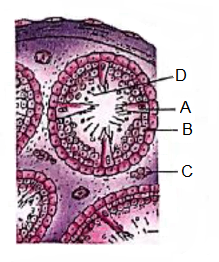 CorrectIncorrect
CorrectIncorrectHint
(d)
-
Question 5 of 110
5. Question
Which of the following is correct about mammalian testes?
CorrectIncorrectHint
(c) : Graafian follicles are present in human ovaries.
-
Question 6 of 110
6. Question
The nutritive cells found in seminiferous tubules are
CorrectIncorrectHint
(c) : Wall of each seminiferous tubule is formed of a single layered germinal epithelium. Majority of cells in this epithelium are male germ cells and at certain places, there are present tall Sertoli cells. These cells act as nurse cells providing nutrition to the developing sperms.
-
Question 7 of 110
7. Question
Sertoli cells are regulated by the pituitary hormone known as
CorrectIncorrectHint
(b) : FSH stimulates Sertoli cells of the testes to secrete an androgen binding protein that concentrates testosterone in the seminiferous tubules. Sertoli cells also secrete a hormone called inhibin which suppresses FSH synthesis.
-
Question 8 of 110
8. Question
If for some reason, the vasa efferentia in the human reproductive system get blocked, the gametes will not be transported from
CorrectIncorrectHint
(a) : Vasa efferentia are fine ciliated ductules that arise from rete testis (a network that joins seminiferous tubules on one side) and open into epididymis which is a mass of long narrow closely coiled tubule lying along the inner side of testis. Epididymis stores the sperms. Thus, if vasa efferentia get blocked, sperms will not be transported from testes to epididymis.
-
Question 9 of 110
9. Question
Read the following statements about the given diagram carefully and state which of them are correct?

(i) A carries urine and sperms.
(ii) B secretes a fluid that helps in the lubrication of penis.
(iii) D produces testosterone but not sperms.
(iv) C stores sperms.CorrectIncorrectHint
(c) : In the given figure, part ‘A’ is vas deferens that carries sperms. Part ‘ \(B\) ‘ is Cowper’s glands that secrete fluid which helps in the lubrication of the penis during copulation. Part ‘ \(C\) ‘ is epididymis that stores sperms and part ‘ \(D\) ‘ is testis that produces sperms and testosterone.
-
Question 10 of 110
10. Question
Given below are the three statements each with two blanks. Select the option which correctly fills up the blank in any two statements.
(A) Each seminiferous tubule is lined on its inside by two types of cells called (i) and (ii).
(B) The seminiferous tubules open into the (i) through (ii).
(C) The enlarged end of penis called the (i) is covered by a loose fold of skin called the (ii).CorrectIncorrectHint
(b)
-
Question 11 of 110
11. Question
Seminal plasma in humans is rich in
CorrectIncorrectHint
(d) : Secretion of seminal vesicles, prostate gland and bulbourethral gland constitute seminal plasma which is rich in fructose, calcium and certain enzymes.
-
Question 12 of 110
12. Question
Prostate glands are located below
CorrectIncorrectHint
(b)
-
Question 13 of 110
13. Question
The function of the secretion of prostate gland is to
CorrectIncorrectHint
(c)
-
Question 14 of 110
14. Question
Match each function below with the associated part or parts of the human male reproductive system shown in the figure.

(i) Produces sperm
(ii) Conducts the sperm through the penis to the outside of the body
(iii) Produces seminal fluid
(iv) Connects the epididymis with the urethraCorrectIncorrectHint
(a) : In the given figure \(A\) is Seminal vesicle, \(B\) is Vas deferens, C is Prostate gland, D is Bulbourethral gland, E is Urethra, F is Epididymis and G is Seminiferous tubules respectively.
-
Question 15 of 110
15. Question
Identify the parts labelled as A to F from the given diagram of human female reproductive system and select the correct option.
 CorrectIncorrect
CorrectIncorrectHint
(a)
-
Question 16 of 110
16. Question
Select the correct option and fill up the blanks in the following paragraph.
_____(i)_____ are the primary female sex organs that produce ___(ii)__ and ____(iii)___. Each primary sex organ is about ___(iv)__ in length and is connected to the pelvic wall and uterus by ____(v)____.CorrectIncorrectHint
(c)
-
Question 17 of 110
17. Question
The given figure depicts a diagrammatic sectional view of the human female reproductive system. Which set of three parts out of I-VI have been correctly identified?
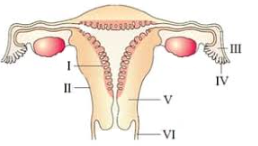 CorrectIncorrect
CorrectIncorrectHint
(b) : In the given figure, I is Endometrium, II is Perimetrium and VI is Vagina.
-
Question 18 of 110
18. Question
The given figure shows female reproductive system. Which wall of the uterus ( \(\mathrm{A}, \mathrm{B}\) or C ) sloughs off during menstruation?
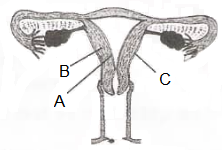 CorrectIncorrect
CorrectIncorrectHint
(a) : In the given figure, ‘A’ is endometrium that sloughs off during menstruation. B represents myometrium and C is perimetrium.
-
Question 19 of 110
19. Question
Lower narrow end of uterus is called
CorrectIncorrectHint
(b) : Lower end of uterus is called cervix that opens into vagina.
-
Question 20 of 110
20. Question
The female external genitalia include
(i) ovary
(ii) mammary gland
(iii) mons pubis
(iv) clitoris
(v) labia majoraCorrectIncorrectHint
(c) : The female external genitalia include mons pubis, labia majora, labia minora, hymen and clitoris.
-
Question 21 of 110
21. Question
Bartholin’s gland are situated
CorrectIncorrectHint
(a) : Bartholin’s glands are a pair of small glands situated on each side of the vaginal opening in human females. They secrete a thick, viscid secretion for lubrication during copulation.
-
Question 22 of 110
22. Question
A sectional view of mammary gland shows
(i) nipple + areola
(ii) mammary lobe, alveolus and duct
(iii) antibodies + pectoralis major muscles + ribs
(iv) ampulla + lactiferous ductCorrectIncorrectHint
(a) : Mammary glands or breasts are modified sweat glands. Each breast contains 15-20 glandular lobes separated from one another by dense connective tissue and adipose tissue. Each lobe is further made of a number of lobules having glandular or secretory alveoli. The cells of alveoli produce milk which is stored in the cavities or lumens of alveoli. Alveoli open into mammary tubules and then into mammary ducts. Mammary ducts form a mammary ampulla from which a lactiferous duct develops. Each lobe produces a separate lactiferous duct. The various lactiferous ducts open at the nipple by separate pores.
-
Question 23 of 110
23. Question
Milk secreted from the cells of alveoli of mammary lobes reaches nipple through lactiferous duct (L), mammary duct (M), mammary tubule (T) and mammary ampulla (A) in the following order
CorrectIncorrectHint
(a) : Mammary glands or breasts are modified sweat glands. Each breast contains 15-20 glandular lobes separated from one another by dense connective tissue and adipose tissue. Each lobe is further made of a number of lobules having glandular or secretory alveoli. The cells of alveoli produce milk which is stored in the cavities or lumens of alveoli. Alveoli open into mammary tubules and then into mammary ducts. Mammary ducts form a mammary ampulla from which a lactiferous duct develops. Each lobe produces a separate lactiferous duct. The various lactiferous ducts open at the nipple by separate pores.
-
Question 24 of 110
24. Question
In humans, at the end of the first meiotic division, the male germ cells differentiate into the
CorrectIncorrectHint
(d)
-
Question 25 of 110
25. Question
\(2 n=16\) is in a primary spermatocyte which is in metaphase of first meiotic division. What shall be the total number of chromatids in each of the secondary spermatocyte?
CorrectIncorrectHint
(a) : Secondary spermatocyte contains half the number of chromosomes, i.e., 8. Each chromosome has 2 chromatids, therefore, 8 chromosomes will have 16 chromatids in all.
-
Question 26 of 110
26. Question
How many sperms are formed from a secondary spermatocyte?
CorrectIncorrectHint
(c)
-
Question 27 of 110
27. Question
How many sperms are formed from four primary spermatocytes?
CorrectIncorrectHint
(c): One primary spermatocyte produces four spermatozoa, therefore, four primary spermatocytes will produce 16 spermatozoa.
-
Question 28 of 110
28. Question
What does the given figure represent?
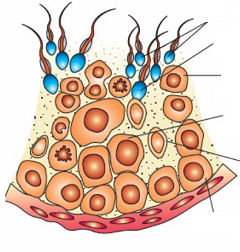 CorrectIncorrect
CorrectIncorrectHint
(b)
-
Question 29 of 110
29. Question
In spermatogenesis, the phase of maturation involves
CorrectIncorrectHint
(c)
-
Question 30 of 110
30. Question
In spermatogenesis, reduction division of chromosome occurs during conversion of
CorrectIncorrectHint
(b)
-
Question 31 of 110
31. Question
Which of the following groups of cells in the male gonad, represent haploid cells?
CorrectIncorrectHint
(c) : In male gonad, germinal epithelial cells, spermatogonium and primary spermatocytes are diploid cells. Secondary spermatocytes, spermatids and spermatozoa represent haploid cells.
-
Question 32 of 110
32. Question
Consider the following statements each with two blanks.
(A) Seminiferous tubules produce (i) while Leydig’s cells produce (ii).
(B) In females, urethra is small and conducts
(iii) while in males it conducts urine and (iv).
(C) The process of formation of spermatozoa from spermatogonia is called (v) and the process of maturation of spermatids into spermatozoa is called (vi).
Which one of the following options, gives the correct fill ups for the respective blank numbers from (i) to (vi) in the statements?CorrectIncorrectHint
(a)
-
Question 33 of 110
33. Question
The process of release of spermatozoa from Sertoli cells into cavity of the seminiferous tubules is called
CorrectIncorrectHint
(d)
-
Question 34 of 110
34. Question
In oogenesis, the secondary follicle soon transforms into a tertiary follicle which is characterised by a fluid filled cavity called
CorrectIncorrectHint
(a) : In human males, the primordial germ cells divide mitotically and produce spermatogonia. Some of the spermatogonia grow into large primary spermatocytes. Each primary spermatocyte undergoes first maturation division which is a reductional (meiotic) one. Thus, the primary spermatocyte divides into two haploid daughter cells called secondary spermatocytes. Each secondary spermatocyte now undergoes second maturation division which is a mitotic one. Thus, each secondary spermatocyte gives rise to two spermatids that undergo transformation to form two sperms. Overall, two secondary spermatocytes give rise to four sperms.
-
Question 35 of 110
35. Question
Given below is an incomplete flow chart showing influence of hormones on gametogenesis in males. Observe the flow chart carefully and identify \(\mathrm{A}, \mathrm{B}\) and C .
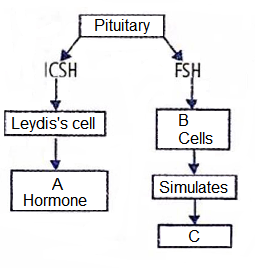 CorrectIncorrect
CorrectIncorrectHint
(d)
-
Question 36 of 110
36. Question
Spermatogenesis is induced by
CorrectIncorrectHint
\(
\text { (a) : FSH acts on the Sertoli cells and stimulate spermatogenesis. }
\) -
Question 37 of 110
37. Question
The given table shows differences between spermatogenesis and spermiogenesis. Select the incorrect option.
\(
\begin{array}{|l|l|l|}
\hline & \text { Spermatogenesis } & \text { Spermiogenesis } \\
\hline \text { (a) } & \text { Process of formation of spermatozoa. } & \begin{array}{l}
\text { Process of differentiation of spermatozoon } \\
\text { from a spermatid. }
\end{array} \\
\hline \text { (b) } & \begin{array}{l}
\text { It changes a haploid structure into another } \\
\text { haploid structure. }
\end{array} & \begin{array}{l}
\text { It involves conversion of a diploid structure } \\
\text { into haploid structure. }
\end{array} \\
\hline \text { (c) } & \text { Growth and divisions occur. } & \text { Divisions and growth are absent. } \\
\hline \text { (d) } & \begin{array}{l}
\text { A spermatogonium forms four } \\
\text { spermatozoa. }
\end{array} & \text { A spermatid forms a single spermatozoon. } \\
\hline
\end{array}
\)CorrectIncorrectHint
(b) : Spermatogenesis involves conversion of a diploid spermatogonia into a haploid spermatozoa whereas spermiogenesis changes a haploid spermatid into a haploid spermatozoon.
-
Question 38 of 110
38. Question
Identify the parts labelled as A, B, C, D and E in the given diagram of a human sperm and select the correct option.
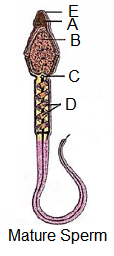 CorrectIncorrect
CorrectIncorrectHint
(b)
-
Question 39 of 110
39. Question
The middle piece of the sperm contains
CorrectIncorrectHint
(b) : The middle piece of whereas sperm contains mitochondria coiled around the axial filament. They provide energy for the movement of the sperm.
-
Question 40 of 110
40. Question
Consider the following three statements related to the human male reproductive system and select the correct option stating which ones are true ( T ) and which ones are false (F).
(i) Middle piece of spermatozoon is also termed as power house of spermatozoon.
(ii) Vas deferens joins a duct from seminal vesicle to form vasa efferentia.
(iii) Semen is a collection of secretions from the seminal vesicles, prostate gland and Cowper’s glands to sperms from testes.CorrectIncorrectHint
(a) : Vas deferens joins a duct from seminal vesicle to form ejaculatory duct.
-
Question 41 of 110
41. Question
The principal tail piece of human sperm shows the microtubular arrangement of
CorrectIncorrectHint
(b) : The axial filament in the tail of human sperm has \(9+2\) microtubular arrangement like that of flagella and cilia.
-
Question 42 of 110
42. Question
A cross section at the midpoint of the middle piece of a human sperm will show
CorrectIncorrectHint
(c) : The middle piece of human sperm contains mitochondria coiled around axial bundle of microtubules. The microtubules are in \(9+2\) arrangement.
-
Question 43 of 110
43. Question
Acrosome is a type of
CorrectIncorrectHint
(a) : Acrosome, a cap-like structure present at the tip of the sperm, is a lysosome like organelle derived from Golgi apparatus. It contains a variety of digestive enzymes that break the egg membrane during penetration of the sperm into the egg.
-
Question 44 of 110
44. Question
Which of the following contains the actual genetic part of a sperm?
CorrectIncorrectHint
(d) : Head of the sperm is anterior, broad, flattened and oval structure. It consists of two parts, posterior large nucleus and anterior small cap-like acrosome. The nucleus consists of condensed DNA and basic proteins.
-
Question 45 of 110
45. Question
The sperms undergo physiological maturation, acquiring increased motility and fertilising capacity in
CorrectIncorrectHint
(c) : In the head of the epididymis, the sperms undergo physiological maturation, acquiring increased motility and fertilising capacity.
-
Question 46 of 110
46. Question
At what stage of life is oogenesis initiated in a human female?
CorrectIncorrectHint
(d) : Oogenesis is the process of formation of functional haploid ova from the diploid germinal cells in the ovary. Oogenesis begins during embryonic development but is completed only after fertilisation of the secondary oocyte with the sperm.
-
Question 47 of 110
47. Question
Total number of follicles in each ovary of a normal young adult woman is about 60,000 to 80,000 . But only 500 follicle get a chance to mature. What is the destiny of rest of the eggs?
CorrectIncorrectHint
(d) : The total number of follicles in each ovary of a normal young adult woman is about 60,000 to 80,000 .
-
Question 48 of 110
48. Question
\(1^{\text {st }}\) polar body is formed at which stage of oogenesis?
CorrectIncorrectHint
(a) : During maturation phase of oogenesis, primary oocyte undergoes first meiotic division and form a large secondary oocyte and a small first polar body.
-
Question 49 of 110
49. Question
In the given T.S. of human ovary identify A to F and select the correct option.
 CorrectIncorrect
CorrectIncorrectHint
(d)
-
Question 50 of 110
50. Question
In ovary we can find
(i) primary follicle
(ii) Graafian follicle
(iii) blood vessel
(iv) corpus luteumCorrectIncorrectHint
(d)
-
Question 51 of 110
51. Question
Which one is released from the ovary?
CorrectIncorrectHint
(b) : Female gamete is released from the ovary in the secondary oocyte stage by rupturing the wall of the ovary.
-
Question 52 of 110
52. Question
In oogenesis, a diploid cell produce _____ ovum/ova.
CorrectIncorrectHint
(a) : In oogenesis, diploid cell (oogonium) produces one ovum and three polar bodies.
-
Question 53 of 110
53. Question
During oogenesis, each diploid cell produces
CorrectIncorrectHint
(c) : In oogenesis, diploid cell (oogonium) produces one ovum and three polar bodies.
-
Question 54 of 110
54. Question
In oogenesis haploid egg is fertilised by sperm at which stage?
CorrectIncorrectHint
(b): In human beings, ovum is released from the ovary in the secondary oocyte stage. The maturation of secondary oocyte is completed in the mother’s oviduct (Fallopian tube) usually after the sperm has entered the secondary oocyte for fertilisation.
-
Question 55 of 110
55. Question
Read the given statements and select the correct option.
Statement 1 : In a Graafian follicle, the primary oocyte and the follicle cells may be regarded sibling cells.
Statement 2 : Both arise from the same parent cell, the oogonium, by mitotic divisions.CorrectIncorrectHint
(a)
-
Question 56 of 110
56. Question
Layers of an ovum from outside to inside is
CorrectIncorrectHint
(a)
-
Question 57 of 110
57. Question
Given here is the figure of a section of Graafian follicle. Identify the labelled parts A to E and select the correct option.
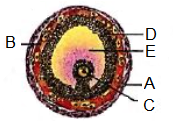 CorrectIncorrect
CorrectIncorrectHint
(d)
-
Question 58 of 110
58. Question
Which part of ovary in mammals acts as an endocrine gland after ovulation?
CorrectIncorrectHint
(d) : After ovulation many of the follicle cells remain in the collapsed follicle on the surface of the ovary. The antrum (cavity of the collapsed follicle fills with a partially clotted fluid. The follicular cells enlarge and fill with a yellow pigment, lutein. Such a follicle is called a corpus luteum. The lutein cells secrete small amount of estradiol hormone and significant amount of the progesterone hormone. Corpus luteum also secretes relaxin hormone.
-
Question 59 of 110
59. Question
Pick the odd one out from each series given below and select the correct option.
(i) Scrotum, Rete testis, Fallopian tube, Vas deferens
(ii) Ovary, Uterus, Vagina, Ejaculatory duct
(iii) Acrosome, Graafian follicle, Corpus luteum, Cervix
(iv) Prostate, Testis, Seminal vesicles, Cowper’s glandCorrectIncorrectHint
(d)
-
Question 60 of 110
60. Question
Mark the odd item in each series and select the correct option.
(i) Spermatocyte; Polar body; Spermatid; spermatogonium
(ii) Endometrium; Corpus luteum; Acrosome; Graafian follicle
(iii) Vas deferens; Fallopian tube; Epididymis; Cowper’s gland
(iv) Sertoli cells, Spermatozoa, Interstitial cells, Cowper’s glandCorrectIncorrectHint
(b)
-
Question 61 of 110
61. Question
Match column I with column II and select the correct option from the codes given below.
\(
\begin{array}{|c|l|c|l|}
\hline & \text { Column I } & & \text { Column II } \\
\hline \text { A. } & \text { Acrosome } & \text { (i) } & \text { Rudimentary erectile tissue } \\
\hline \text { B. } & \text { Endometrium } & \text { (ii) } & \text { Uterus } \\
\hline \text { C. } & \text { Polar body } & \text { (iii) } & \text { Oogenesis } \\
\hline \text { D. } & \text { Clitoris } & \text { (iv) } & \text { Spermatozoon } \\
\hline
\end{array}
\)CorrectIncorrectHint
(b)
-
Question 62 of 110
62. Question
\(
\text { Select the correct match. }
\)CorrectIncorrectHint
(a) : Secondary oocyte is formed by meiotic division of primary oocyte \((2 n)\), therefore, it is haploid. Primary spermatocyte is formed by mitotic division of spermatogonium \((2 n)\), therefore it is diploid.
-
Question 63 of 110
63. Question
Given below is an incomplete flow chart showing influence of hormones on gametogenesis in human females. Study it carefully and identify A, B, C and D.
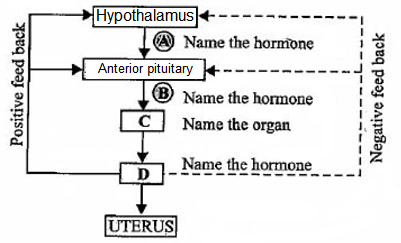 CorrectIncorrect
CorrectIncorrectHint
(b)
-
Question 64 of 110
64. Question
The following graph shows the levels of pituitary hormones during a menstrual cycle. What do 1 and 2 represent?
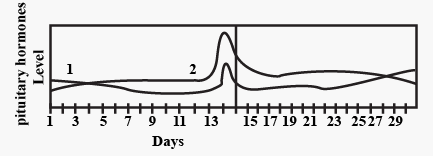 CorrectIncorrect
CorrectIncorrectHint
(c) : In the given graph, 1 and 2 are FSH and LH respectively. The secretion of both LH and FSH attain peak level during the ovulation ( \(14^{\text {th }}\) day of the cycle).
-
Question 65 of 110
65. Question
The following graph shows the levels of ovarian hormones during a menstrual cycle. What do 1 and 2 represent?
 CorrectIncorrect
CorrectIncorrectHint
(b): In the given graph, 1 and 2 are estrogen and progesterone respectively. The level of estrogen and progesterone is reduced during the menstrual phase. During follicular phase, level of estrogen is increased and during luteal phase, level of progesterone increases.
-
Question 66 of 110
66. Question
The accompanying diagram shows the changes that take place in the endometrium during a normal menstrual cycle. Identify the changes and select the correct option.
 CorrectIncorrect
CorrectIncorrectHint
(c) : Menstruation occurs for 1-5 days and ovulation occurs on \(14^{\text {th }}\) day of a normal menstrual cycle.
-
Question 67 of 110
67. Question
The phase of menstrual cycle in humans that last for \(7-8\) days, is
CorrectIncorrectHint
(a)
-
Question 68 of 110
68. Question
During proliferative phase,
CorrectIncorrectHint
(c) : During proliferative phase, estrogen secreted from ovarian follicles under the influence of FSH, causes proliferation of the endometrium of the uterine wall.
-
Question 69 of 110
69. Question
Proliferation of endometrium during follicular phase is undertaken by
CorrectIncorrectHint
(c) : During proliferative phase, estrogen secreted from ovarian follicles under the influence of FSH, causes proliferation of the endometrium of the uterine wall.
-
Question 70 of 110
70. Question
In the 28 days human ovarian cycle, the ovulation takes place typically on
CorrectIncorrectHint
(b)
-
Question 71 of 110
71. Question
The time for optimum chances of conception in a woman is ______ starting from the day of menstruation.
CorrectIncorrectHint
(c): On the \(14^{\text {th }}\) day of menstrual cycle, ovulation occurs, so chances of conception are optimum.
-
Question 72 of 110
72. Question
Ovulation in the human female normally takes place during the menstrual cycle
CorrectIncorrectHint
(d) : Proliferative phase includes days 6-13 of cycle and ovulation occurs on day 14 .
-
Question 73 of 110
73. Question
After ovulation, Graafian follicle regresses into
CorrectIncorrectHint
(c) : During ovulatory phase, LH induces rupturing of Graafian follicle and during secretory phase, empty Graafian follicle changes into corpus luteum.
-
Question 74 of 110
74. Question
Immediately after ovulation, the mammalian egg is covered by a membrane known as
CorrectIncorrectHint
(c) : Immediately after ovulation, the layer that forms around the ovum is called corona radiata. It is formed by the granulosa cells of cumulus oophorus. Corona radiata probably increases the Illelithood that the ovum will be picked up in the uterine tube.
-
Question 75 of 110
75. Question
Below is given the unorganised list of some important events in the human female reproductive cycle. Identify the correct sequence of these events and select the correct option.
(i) Secretion of FSH
(ii) Growth of corpus luteum
(iii) Growth of the follicle
(iv) Ovulation
(v) Sudden increase in the levels of LHCorrectIncorrectHint
(d)
-
Question 76 of 110
76. Question
Which one of the following is the correct matching of the events occurring during menstrual cycle?
CorrectIncorrectHint
(b)
-
Question 77 of 110
77. Question
Which one of the following events is correctly matched with the time period in a normal menstrual cycle?
CorrectIncorrectHint
(b) : The endometrium of the uterus breaks down during menstrual cycle. It regenerates after \(5-10\) days.
-
Question 78 of 110
78. Question
A regular cycling woman is not menstruating. Which one of the following is the most likely root cause of this?
CorrectIncorrectHint
(d) : Menstruation does not take place if the ovum is fertilised.
-
Question 79 of 110
79. Question
Read the following statements about menstrual cycle and select two correct statements.
(i) Lack of menstruation may be indicative of pregnancy.
(ii) The changes in the ovary and the uterus are induced by changes in the levels of ovarian hormones only.
(iii) LH surge induces ovulation.
(iv) If fertilisation occurs, corpus luteum degenerates immediately.CorrectIncorrectHint
(c) : Lack of menstruation may be indicative of pregnancy. During pregnancy, the levels of estrogen and progesterone are high in the blood, which are required for the maintenance of uterus and thus, menstruation does not occur. On \(14^{\text {th }}\) day of the menstrual cycle, there is rapid increase in LH (called LH surge), that induces ovulation. The changes in the ovary and the uterus are induced by changes in the levels of ovarian hormones and pituitary hormones. If fertilisation occurs, corpus luteum degenerates by \(16^{\text {th }}\) week of pregnancy.
-
Question 80 of 110
80. Question
If mammalian ovum fails to get fertilised, which one of the following is unlikely?
CorrectIncorrectHint
(c) : If ovum fails to get fertilised, then corpus luteum (source of progesterone and estrogen) will disintegrate resulting in decrease in the level of progesterone and estrogen. Thus, endometrial lining of the uterus sloughs off and menstruation begins, marking a new cycle.
-
Question 81 of 110
81. Question
During bleeding phase of menstrual cycle unfertilised secondary oocyte undergoes autolysis. The interplay of hormones then is
CorrectIncorrectHint
(c) : If fertilisation does not occur, the secondary oocyte undergoes autolysis and progesterone (secreted by persistent corpus luteum) inhibits the release of LH from pituitary. Reduction of LH level causes regression of corpus luteum by autolysis and thus fall in the progesterone level in the blood. Due to deficiency of progesterone, uterine lining sloughs off causing bleeding. This whole phase is called bleeding phase.
-
Question 82 of 110
82. Question
A human female reaches menopause around the age of
CorrectIncorrectHint
(a)
-
Question 83 of 110
83. Question
Cessation of menstrual cycle in a woman is called
CorrectIncorrectHint
(c) : Menopause is a phase occurring between the age of 45 to 55 years in woman’s life when ovulation and menstruation stop.
-
Question 84 of 110
84. Question
Name the hormone that has no role in menstruation.
CorrectIncorrectHint
(d) : Adrenaline hormone has no role in menstruation.
-
Question 85 of 110
85. Question
Study the graph carefully and correlate the hormone levels on
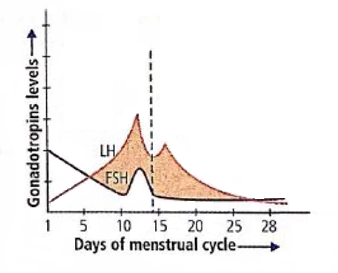
(i) 1-5 days
(ii) 12-14 days
(iii) 25-28 days (if the ovum is not fertilised).CorrectIncorrectHint
(c)
-
Question 86 of 110
86. Question
The given figure shows schematic representation of a menstrual cycle in human female. Identify the three phases ( A, B and C ) of menstrual cycle.
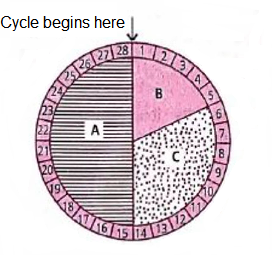
 CorrectIncorrect
CorrectIncorrectHint
(c)
-
Question 87 of 110
87. Question
Some important events that occur during the menstrual cycle are given below. Arrange the events in a proper sequence and select the correct option.
(i) Proliferation of endometrial wall
(ii) LH surge
(iii) Secretion of estrogen
(iv) Secretion of progesterone
(v) Ovulation
(vi) Growth of corpus luteum
(vii) Degeneration of corpus luteum
(viii) MenstruationCorrectIncorrectHint
(b)
-
Question 88 of 110
88. Question
Withdrawal of which of the following hormones is the immediate cause of menstruation?
CorrectIncorrectHint
(a) : Progesterone is required for the maintenance of the endometrial lining of the uterus. As soon as the production of progesterone is reduced due to reduction in the production of LH from anterior lobe of the pituitary, the endometrium of the uterus breaks down and menstruation begins.
-
Question 89 of 110
89. Question
For human female which of the following is incorrect?
CorrectIncorrectHint
(c) : During pregnancy, high levels of progesterone inhibits FSH and LH secretion. In absence of these hormones, there is no chance of ovulation and thus no pregnancy.
-
Question 90 of 110
90. Question
At menopause there is rise in urinary excretion of
CorrectIncorrectHint
(a) : During menopause, the level of estrogen in the blood decreases. Thus, estrogen can no longer inhibit the production of FSH and LH. Therefore, FSH and LH (mainly FSH) are produced after menopause in large quantities and these (mainly FSH) are excreted out in urine.
-
Question 91 of 110
91. Question
Which of the following statements concerning menopause is correct?
CorrectIncorrectHint
(c) : Menopause is a phase in woman’s life when ovulation and menstruation stop. According to one theory decline in estrogen and progesterone level leads to menopause.
-
Question 92 of 110
92. Question
Fertilisation is defined as the process by which
CorrectIncorrectHint
(b)
-
Question 93 of 110
93. Question
A reaction of granules content which harden the zona pellucida and ensures sure block to polyspermy is
CorrectIncorrectHint
(b) : Immediately after the fusion of sperm and plasma membranes of secrete the secondary oocyte shows a cortical reaction. In this reaction, the cortical granules present beneath the secondary oocyte’s plasma membrane fuse with the plasma membrane and release enzymes between it and zona pellucida. These enzymes harden the zona pellucida, which now functions to block polyspermy.
-
Question 94 of 110
94. Question
Fill up the blanks in the following paragraph by selecting the correct option.
During copulation (coitus), semen is released by the penis into the vagina and is called (i). The ovum released by the ovary is transported to the (ii) where (iii) takes place. During fertilisation, a sperm comes in contact with the zona pellucida layer of the ovum and induces changes in the membrane that block the entry of (iv). The secretions of the (v) help the sperm enter into the cytoplasm of the ovum.CorrectIncorrectHint
(a)
-
Question 95 of 110
95. Question
Which part of the sperm plays an important role in penetrating the egg membrane?
CorrectIncorrectHint
(d) : Acrosome contains a variety of digestive enzymes that break the egg membrane during penetration of the sperm into the egg.
-
Question 96 of 110
96. Question
The second maturation division of the mammalian ovum occurs
CorrectIncorrectHint
(b) : During oogenesis, primary oocyte grows and completes meiosis I (first maturation division) producing a large secondary oocyte and a small polar body. The secondary oocyte proceeds. with meiosis II (second maturation division) but the division gets arrested at metaphase stage. It is in this stage of oocyte that the ovum is shed during ovulation. It passes into oviduct, where the cell cycle resumes only after the entry of sperm.
-
Question 97 of 110
97. Question
In oocyte secondary maturation occurs in
CorrectIncorrectHint
(c): In the secondary oocyte, the meiotic division is arrested at the metaphase stage. After ovulation, secondary oocyte passes into fallopian tube, where meiosis II is completed only after the entry of sperm.
-
Question 98 of 110
98. Question
Besides activating the egg, another role of a sperm is to carry egg to
CorrectIncorrectHint
(c): During fertilisation, the head of the sperm containing nucleus (DNA) enters the egg leading to the formation of diploid zygote.
-
Question 99 of 110
99. Question
The sperm and the egg make different contributions to zygote. Which of the following statements about thei contributions are true?
(i) Sperm contributes most of the mitochondria.
(ii) Egg contributes most of the cytoplasm.
(iii) Both sperm and egg contribute haploid nucleus.
(iv) Both sperm and egg contribute centrioles.CorrectIncorrectHint
(b) : Egg is larger in size as compared to the sperm, therefore, it contributes most of the cytoplasm during fertilisation besides only sperm head containing nucleus enters egg during fertilisation. Haploid nucleus is contributed by both sperm and egg.
-
Question 100 of 110
100. Question
Some important events that take place during fertilisatior are given below. Arrange the events in a proper sequence and select the correct option.
(i) Cortical reaction
(ii) Sperm entry
(iii) Karyogamy
(iv) Acrosomal reactionCorrectIncorrectHint
(a)
-
Question 101 of 110
101. Question
Preparation of sperm before penetration of ovum is
CorrectIncorrectHint
(d) : The secretions of the female genital tract remove coating substances deposited on the surface of the sperms particularly those on the acrosome. Thus, the receptor sites on the acrosome are exposed and sperm becomes active to penetrate the egg. This phenomenon of sperm activation in mammals is known as capacitation.
-
Question 102 of 110
102. Question
The sex of the fetus will be decided at
CorrectIncorrectHint
(a)
-
Question 103 of 110
103. Question
What is true about cleavage in the fertilised egg in humans?
CorrectIncorrectHint
(a) : Cleavage in the fertilised egg starts in the fallopian tube. It is holoblastic. There is no growth phase, so it differs from mitosis.
-
Question 104 of 110
104. Question
Cleavage differs from mitosis in lacking
CorrectIncorrectHint
(b) : Cleavage in the fertilised egg starts in the fallopian tube. It is holoblastic. There is no growth phase, so it differs from mitosis.
-
Question 105 of 110
105. Question
The solid mass of 8-16 cells formed from zygote after successive mitotic divisions is called
CorrectIncorrectHint
(c)
-
Question 106 of 110
106. Question
Given below are four statements (i)-(iv) regarding embryonic development in humans.
(i) Cleavage divisions bring about considerable increase in the mass of protoplasm.
(ii) With more cleavage divisions, the resultant blastomeres become smaller and smaller.
(iii) The blastomeres in the blastocyst are arranged into two layers, trophoblast and endometrium.
(iv) Cleavage divisions result in a solid ball of cells called morula.
Which of the above two statements are correct?CorrectIncorrectHint
(b): Interphase in cleavage division is short and does not involve growth so that the resulting blastomeres become smaller in size as their number increases. During cleavage, at \(8-16\) celled stage, a solid ball of cells called morula (as it look like mulberry) is formed. In cleavage, there is increased mobility of protoplasm. The blastomeres in the blastocyst get arranged into outer layer called trophoblast and an inner group of cells attached to trophoblast called the inner cell mass.
-
Question 107 of 110
107. Question
Identify the human developmental stage shown as well as the related right place of its occurrence in a normal pregnant woman and select the right option for the two, together. [Main 2012]
 CorrectIncorrect
CorrectIncorrectHint
(c) : After fertilisation, a single-celled zygote develops into a multicellular structure called blastocyst. This blastocyst then gets embedded in the endometrium of the uterus and the process is known as implantation.
-
Question 108 of 110
108. Question
Read the given statements and select the correct option.
Statement 1 : Upto morula stage, the cells divide without any increase in size.
Statement 2 : Cell division convert unicellular zygote into a multicellular embryo.CorrectIncorrectHint
(a)
-
Question 109 of 110
109. Question
Match column I with column II and select the correct option from the codes given below.
\(
\begin{array}{|c|l|c|l|}
\hline & \text { Column I } & & \text { Column II } \\
\hline \text { A. } & \text { Cleavage } & \text { (i) } & \text { Fertilisation } \\
\hline \text { B. } & \text { Morula } & \text { (ii) } & \text { Mitotic divisions } \\
\hline \text { C. } & \text { Polyspermy } & \text { (iii) } & \text { Endometrial } \\
\hline \text { D. } & \text { Implantation } & \text { (iv) } & \text { Little mulberry } \\
\hline
\end{array}
\)CorrectIncorrectHint
(a)
-
Question 110 of 110
110. Question
Implantation takes place after _____ of fertilisation.
CorrectIncorrectHint
(c): Implantation is embedding of the blastocyst into endometrium of uterus. Implantation begins about \(7^{\text {th }}\) day after fertilisation of ovum and it takes about 3 days for the process to be completed.